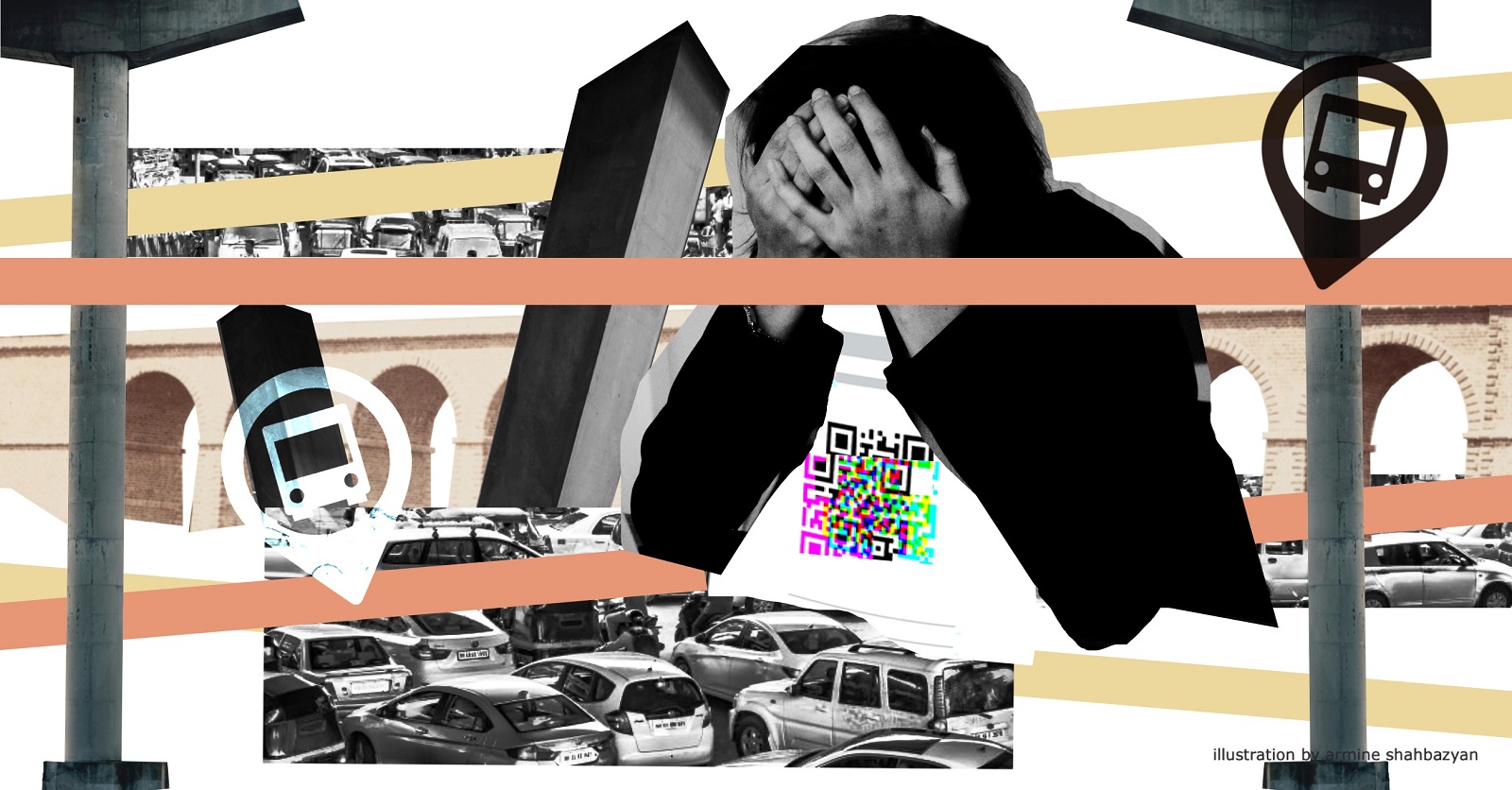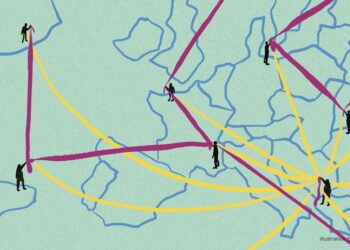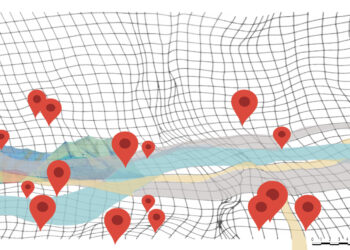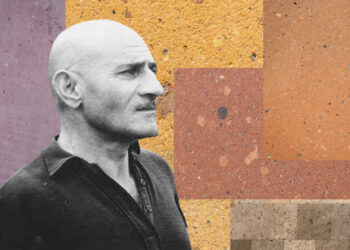
Listen to the article.
Every day around 6 p.m., a large crowd gathers at the bus stop near the Opera House in downtown Yerevan. As buses approach, people surge toward the doors, vying for a spot. Some passengers drop coins into the fare machine, others hand them to the driver, and a few opt for the online payment system. Once aboard, they are crammed shoulder to shoulder, their breaths mingling in the stifling space. Missing the bus means waiting another 15 to 20 minutes––and, with congested streets, arriving even later at their destination.
The ride itself feels more like a rollercoaster, with drivers weaving between lanes and making abrupt stops that send the crowd lurching forward. During rush hour, the sheer density of commuters prevents anyone from actually falling, however, on quieter days, sudden stops have caused people to lose balance and fall. Despite ongoing reforms, this chaotic and uncomfortable daily commute shows little signs of improvement.
Over the past few years, public transportation in Yerevan has become both a source of public frustration and a target for municipal reform. The Yerevan municipality has introduced new Chinese- and German-made buses, installed cashless payment systems on buses and at metro stations, and even enabled passengers to track bus arrivals online through the Yandex app. Yet, despite these visible improvements, the daily reality for many commuters remains the same. While evolving, the city’s transportation system still struggles with significant unresolved issues.
The Unified Ticketing System
While cities worldwide embrace sustainable and innovative public transport solutions, Yerevan is still transitioning away from cash-based fare payments. A unified, cashless payment and ticketing system stands as a key component of Yerevan’s public transport reforms.
In 2022, the Yerevan municipality informed EVN Report that the unified payment system would allow passengers to pay using special passes, bank cards, and a dedicated app. Though initially promised to launch in autumn of 2022, a version of this system was finally implemented in new buses only in September of last fall. The system, managed by TelCell Wallet, features electronic payment devices that scan QR codes, which passengers can obtain through the TelCell app or through payment terminals.
In September of this year, Yerevan’s metro also introduced a cashless payment system. Initially, all entry gates were converted to support the cashless payment system while leaving just one gate for traditional tokens. This led to long lines as most passengers were still using tokens. To ease these queues, the metro offered two alternatives: passengers could generate QR codes through TelCell payment terminals or purchase QR-coded tickets from cashiers. Despite these options, lines remained long, partly due to technical issues with the cashless payment devices. By mid-October, the metro fully transitioned to QR codes and discontinued tokens entirely. The situation has since improved, with passengers adapting to the electronic payment system and shorter lines at stations.
While commuters adapted to using the cashless payment system in the metro within two months, electronic payments remained low on buses as most people preferred paying with coins—either putting coins into designated machines in the buses by the driver or by giving money directly to the driver. Most machines only accept 100 dram coins, while a few buses (approximately 87 German-made MAN buses)—accept 50, 200, and 500 dram coins and provide change. Previously, passengers would pay cash, and drivers would provide change. The municipality argued that this made bus fare payments less transparent.
As of early October, cashless payments made up 21.5% of transactions in the metro, 8% on trolleybuses, and only 2.4% on buses. Mayor Tigran Avinyan expressed concern that without significant increases in these numbers, rolling out the full unified payment system in January would be problematic.
Starting November 1, as preparation for the unified ticketing system’s full launch in January 2025, bus fares on newly purchased buses (MAN, ZhongTong, and Gazel-City) can only be paid using 100-dram coins or QR codes (either through the TelCell app or by purchasing printed QR codes). This gradual approach aims to help commuters adapt to the upcoming changes. Mayor Avinyan emphasized that limiting payment to these two options will ensure consistent revenue growth, reduce informal transactions, and smooth the transition to the unified ticketing system. “If we aim to build a continuously advancing public transport system in Yerevan, we ask for your support by either using the ticketing system or, at minimum, always having a 100-dram coin until the full transition to the unified system,” he stated during a city council meeting. While bank card payments remain unavailable, TelCell representatives confirmed their equipment can process such payments. However, the company chose to delay enabling this feature to encourage QR code adoption.
When the new changes to public transportation were introduced in Yerevan at the start of November, commuters in Yerevan—especially seniors—were unsettled. While younger people easily adapted to the new system, elderly residents encountered significant challenges. The app requires users to take a selfie with their ID card or passport for activation, a process that proves difficult even for tech-savvy users. The system then requires multiple steps to generate a QR code for payment. Many seniors remain hesitant to adopt this app-based payment system.
Just a few days into the new system, people have begun to adapt. On November 1, many passengers lacked QR codes or 100 dram coins––some were denied entry while bus drivers simply allowed others to ride for free as they did not have 100 dram coins or QR codes. Since then, most have found ways to pay, either using electronic QR codes or printing multiple QR codes from terminals for future rides. Yet questions remain about why the municipality did not implement the simpler payment options like bank cards and NFC (Near Field Communication—a wireless communication technology that enables short-range data exchange between two devices, including payments) during the transition period. Issuing bus passes could have also eased the transition. While modernizing to electronic payments and bus cards is a welcome and overdue change, starting with QR codes and a complicated app has created unnecessary difficulties.
The first three days after launch showed steady growth in electronic payments: QR code usage rose from 16.5% of passengers on November 1 to 21.9% on November 2, reaching 26.1% by November 3.
Three days after launching the new system, Mayor Avinyan explained that the unified ticketing system’s partial rollout two months before full implementation was intended to identify potential issues. He acknowledged the payment challenges and assured that bank card payment functionality would be resolved soon. The mayor confirmed that bank card payments would be operational before January 1, 2025, along with the introduction of bus passes. Thereby, beginning in January, the unified payment system will support multiple payment options: single-use paper tickets with QR codes, a mobile application, reusable bus cards, and bank cards.
Avinyan noted that despite initial challenges, Yerevan residents have shown a good understanding of the unified ticketing system, and the municipality is satisfied with the progress.
Bus Fares Will Increase
Yerevan’s public transport system will see an increase in bus fares. Currently, a single ride on buses and the metro costs 100 Armenian drams. In March, the Yerevan municipality approved a new fare package that was initially set to begin in September. The implementation was postponed to January 1, 2025, to coincide with the launch of the unified ticketing system and the arrival of new buses to the fleet. This delay occurred because the new buses have not yet arrived.
The new fare structure offers three options: monthly, quarterly, and annual passes, each with different rates for physical and digital payments. For physical passes, the fees are 9,000 drams monthly, 24,000 drams quarterly, and 90,000 drams annually. Digital payments offer slightly lower rates at 8,800 drams monthly, 23,600 drams quarterly, and 88,000 drams annually.
Additionally, in mid-November the City Council also approved a package of benefits for public transportation users. Under the new package, public transportation will be free for children under 7, people with disabilities, individuals under state care (such as in orphanages and senior citizen’s homes), national heroes, and parents of four or more children. Additionally, groups such as schoolchildren, pensioners, students, and those receiving state support will be eligible for discounts on public transportation fares ranging from 15-30%.
Despite these changes, Yerevan residents still cannot track bus arrival times on electronic timetables at bus stops. According to the municipality, these timetables remain in the design phase, with no set installation date. Rather than develop a single app for both bus tracking and fare payments, the municipality has split these functions—outsourcing payments to TelCell and tracking to Yandex.
New Buses, Old Problems
Replacing the outdated fleet of worn, uncomfortable minivans with new and more comfortable buses is a key part of Yerevan’s public transport reforms.
The Yerevan municipality has been gradually introducing new buses––primarily Chinese-manufactured—to replace old vehicles. The reform aims to streamline the fleet from 1,922 vehicles to 845. The current fleet includes 391 new Chinese-made buses, 87 new German-made buses, 131 older Chinese-made buses, and 100 relatively new Russian small-class buses. Private companies run an additional 133 buses. In early November, the municipality announced that 171 new buses had arrived in the city, scheduled to join the fleet in January. This addition will bring the total number of new buses acquired to 649.
The consolidation of bus routes, along with the acquisition of new buses and retirement of older models, has reduced the total number of vehicles on Yerevan’s streets. To complete the public transport reforms and fleet modernization, the municipality plans to purchase an additional 150-200 buses.
As part of its sustainable transport initiatives, the municipality has also been modernizing the trolleybus fleet, introducing 15 new trolleybuses in 2022 and acquiring 15 more this year.
Despite these improvements, the bus system still faces significant challenges. Overcrowding remains common and buses frequently run late, especially during peak hours. Although a primary goal of Yerevan’s transportation reforms is to provide residents with a comfortable and efficient alternative to private vehicles—and thereby reduce traffic congestion—this goal has yet to be achieved.
The total network length will be reduced from 3,961 km to 1,134 km by eliminating overlapping lanes and reducing the fleet size. While routes will be shortened, the number of bus stops will increase. With buses running on fixed schedules, traffic flow will remain smooth.
Yerevan is prioritizing dedicated lanes for public transportation. In the initial phase, a unified corridor will connect several administrative districts, ensuring unobstructed public transit flow. The corridor will extend from the Kentron district toward Arshakunyats, Garegin Nzhdeh, and Bagratunyats streets. Discussions are also underway to connect the Nor Nork district to Arabkir and extend access to Malatia-Sebastia.
The Yerevan Municipality has created dedicated bus lanes on Abovyan, Moskovyan, Isahakyan, and Saralanj streets, as well as on GAI and Mashtots Avenues—ensuring buses maintain their schedules. The municipality reports these dedicated lanes have not caused additional problems, and they continue to optimize traffic organization.
The Metro
The metro offers more efficient travel with consistent arrival times and freedom from traffic congestion. However, the Yerevan Metro has only one line with ten stops, serving a limited area of the city. While convenient for those who live, work, or study near stations, it may not be practical for others.
The municipality has announced plans to expand the metro line––an expensive and time-consuming project. The immediate goal is to add one more stop by 2028. Although metro expansion is essential for developing a fully functional and comfortable public transportation system, this will be a years-long process. For now, the success of ongoing reforms remains to be seen.
Also see
Recently published
Armenia’s Diplomatic Footprint
Armenia's diplomatic footprint reveals its foreign policy goals and challenges: enhancing security, fostering economic ties and amplifying its international presence. Hovhannes Nazaretyan examines how Armenia is positioning itself globally.
Read moreRethinking Monument Preservation in Armenia
Armenia is developing policies to inventory, preserve, restore and promote historical monuments, recognizing their economic and cultural value. While progress aligns with sustainable development goals, significant challenges in preservation and management persist.
Read moreThe Revered and Overlooked Legacy of Rafayel Israelyan
Rafayel Israelyan, one of the most prolific architects of the Armenian world, left an enduring mark on Armenia’s architectural landscape with his visionary designs that included memorials, fountains, bridges, churches, government buildings, and more. Despite his remarkable contributions, his legacy is underappreciated.
Read more






